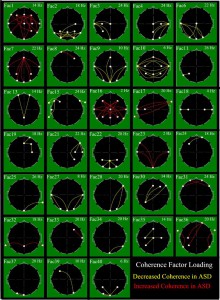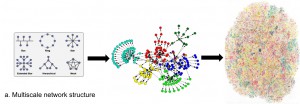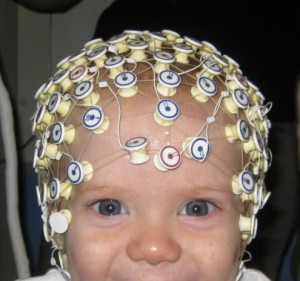People sometimes say that children with autism “march to a different drummer” or “vibrate at a different frequency.” New research analyzing electrical activity in the brain—via electroencephalography, or EEGs—makes it tempting to speculate that these clichés have some truth to them.
EEGs have been around for close to 100 years, and are relatively cheap. But interpretation of these squiggly lines has barely scratched the surface of what they can tell us.
Recent research suggests that EEGs might have a lot to say about how the brain is connected up, and how it processes and integrates information. These messages—if we could properly hear them—might someday help clinicians diagnose autism much earlier than they can now.
The EEG tracks different kinds of rhythms, which show up as waves that oscillate at varying frequencies. Charles A. Nelson, PhD, director of the Labs of Cognitive Neuroscience at Boston Children’s Hospital, examined these waves—alpha, beta, delta, gamma, theta—in 65 infant siblings of children with autism, who are considered to be at increased risk for autism themselves (a 1-in-5 risk as compared with 1:100 in the general population).
As early as 6 months of age, the infants showed a signature pattern in the frontal regions of their brains: EEG signals were weaker across all frequencies when compared with a control group of 57 infants without a sibling with autism. The rates of change in signal power during their first two years of life were also measurably different, suggesting their brains were on a different developmental path.
But what’s interesting is that high-risk infants who didn’t actually develop autism showed these EEG patterns, too—suggesting that they were born with a predisposition to autism that they somehow overcame. “We think there’s something in the brain that represents a possible genetic bias toward autism, yet most kids with this bias don’t develop it,” says Nelson. “Something else might be compensating for it.”
A deeper dive
Frank Duffy, MD, director of Developmental Neurophysiology at Boston Children’s, is a neurologist trained in electrical engineering and mathematics. He knows a great deal about EEGs, and suspected that a deeper, quantitative analysis of the signal might reveal a difference in how the autistic brain is organized.
“There’s a huge amount of information in an EEG signal that you can’t see,” says Duffy.

(Click to enlarge) These schematics show 33 brain EEG "coherence factors" distinguishing children with autism from neurotypical controls. The 23 factors in yellow have decreased coherence in autism; the 10 in red have increased coherence in autism. Factor 15, reflecting coherence in language areas in the brain’s left hemisphere, was a strong predictor of autism even taken alone. (Courtesy Frank Duffy)
Digging into his archive of raw EEG data, some more than a decade old, Duffy used computational techniques to investigate “coherence”—the degree of synchrony between any two given EEG signals. If two or more EEG waves rise and fall together over time, their coherence is high, indicating that those brain regions are tightly connected—like two singers carrying a tune in synch.
Duffy studied 430 children with “classic” autism (eliminating high-functioning autism or Asperger’s syndrome) and 554 neurotypical controls. For each child, he generated coherence readings from the entire brain—more than 4,000 different combinations of electrode signals, across all frequencies. He then looked for readings that varied the most from child to child.
In general, in the children with autism, EEG signals at short distances from each other tended to have reduced coherence. Long-distance coherence, compared with neurotypical children, was sometimes reduced and sometimes increased.
These differences are consistent with the idea of altered “connectivity” in the brains of people with autism. But Duffy went further, zeroing in on 33 coherence readings that consistently distinguished the children with autism from the controls, with a sensitivity upwards of 90 percent. He now wants to repeat his study in children with Asperger’s syndrome, those with genetic disorders like Fragile X syndrome, and perhaps—inspired by Nelson’s findings—siblings of children with autism.
To Duffy’s eye, the coherence data seem to suggest that the brain circuitry in autism may be “damped” and not functioning efficiently. Imagine the difference in sound when you strike a crystal goblet versus a coffee mug. The goblet will produce a sustained, pure note, vibrating at a single frequency, whereas the mug’s sound is muted and brief, spanning multiple frequencies, because it physically can’t vibrate as freely as the glass goblet can. In autism, the brain circuitry seems to behave more like the coffee mug—something is preventing the circuits from oscillating as they should.
“Maybe that’s why, when you talk to an autistic child, you have to make it loud, repetitive,” Duffy speculates. “The circuitry is there, but it’s not responding well; it’s not as easy to get it going. Maybe that’s why autistic kids don’t receive information easily.”
Chaos theory
Bill Bosl, PhD, of the Informatics Program at Boston Children’s Hospital, is a computational physicist with no prior background in medicine. Formerly, he analyzed complex wave patterns to discern the location of groundwater, oil deposits and fault lines. About six years ago, he left geophysics and began in-depth studies of clinical neuroscience, searching EEG data for signs of unusual thought patterns. “The mathematical methods are very similar,” he says.
Last year, in collaboration with Nelson, Bosl published a study analyzing EEGs from infants at risk for autism versus controls. He looked at a characteristic called entropy, a measure borrowed from chaos theory.

The entropy in an EEG signal may reveal underlying connection patterns between neurons and groups of neurons in the brain. (Courtesy Bill Bosl)
Entropy quantifies the degree of randomness in a signal—similar to how scientists would approach a signal from outer space—to determine whether it contains information. Like coherence data, measurement of entropy might give information on how the brain is wired—the density of neurons in each part of the brain, how connections between them are organized and the balance of short- and long-distance connections. In Bosl’s study, the entropy measures had 80 percent accuracy in distinguishing 9-month-olds at high risk for autism from controls.
In many parts of the world, and even the United States, there’s a shortage of neurologists and developmental medicine specialists who can screen for autism behaviorally—while EEGs are often relatively accessible. If these wiggly lines prove to be trustworthy indicators, there could be a future in which EEGs are used routinely to screen children for autism, particularly in underserved areas.
Perhaps an inexpensive EEG headset could be put on at well-child visits to monitor brain development. Or perhaps EEGs could be taken at birth, as part of newborn screening, and sent to a central location for processing.
Perhaps an old technology could help children at risk get interventions sooner—when they’re most likely to alter the path of autism.










